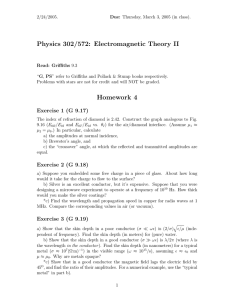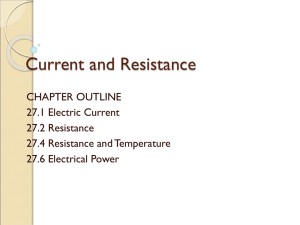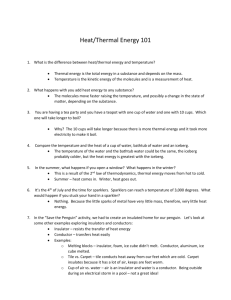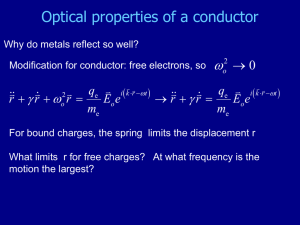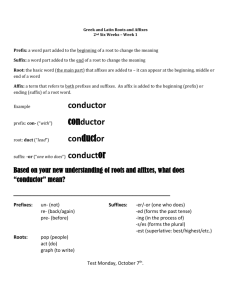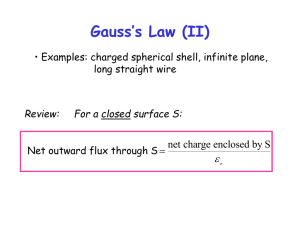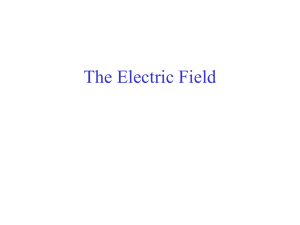CLASSIFICATION OF CRITICAL AGING SEGMENTS OF POWER TRANSMISSION LINES
advertisement
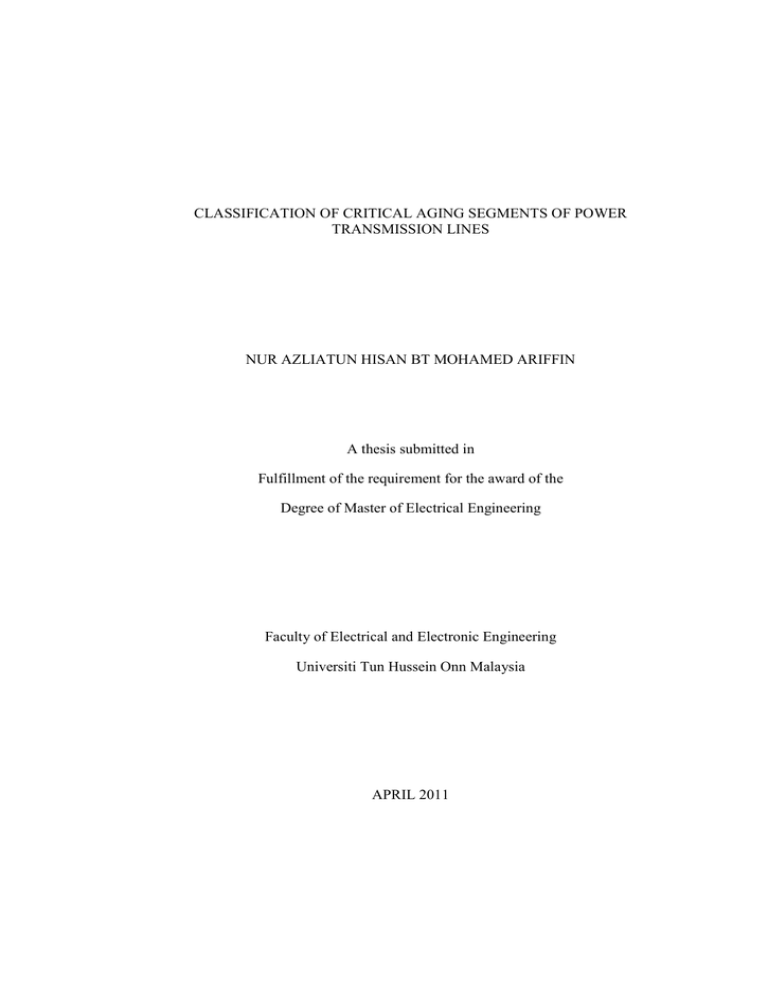
CLASSIFICATION OF CRITICAL AGING SEGMENTS OF POWER
TRANSMISSION LINES
NUR AZLIATUN HISAN BT MOHAMED ARIFFIN
A thesis submitted in
Fulfillment of the requirement for the award of the
Degree of Master of Electrical Engineering
Faculty of Electrical and Electronic Engineering
Universiti Tun Hussein Onn Malaysia
APRIL 2011
iv
ABSTRACT
An Analytic Hierarchy Process (AHP) approach been used for analysis, comparison and
classify the quality of several parameters that affect the conductor thermal ratings. The
method is based on pairwise comparison between several factors that affect the
alternatives in a hierarchical structure. The thermal ratings of power transmission lines is
basically based on the maximum permissible temperature of the conductors. Conductor
can lose their tensile strength due to thermal load or annealing. This paper analysis
thermal aging using known characteristics of transmission conductor, load information
and weather data. By analyzing the conductor temperatures, aging due to loss of
conductor tensile strength is estimated at individual locations along the transmission
corridor. The proposed methodology is illustrated using a case study analyzing a power
transmission line in Kluang, Johor. This information is important for transmission
network operating procedures, scheduling of line inspections, maintenance, or
reconductoring.
v
ABSTRAK
“Analytical Hierarchy Process (AHP)” adalah satu kaedah yang digunakan untuk
membuat analisa, perbandingan and mengklasifikasikan kualiti beberapa parameter yang
mempengaruhi kadar terma konduktor. Kaedah ini berdasarkan perbandingan secara
pasangan diantara beberapa factor yang mempengaruhi alternatif pada struktur hierarki.
Kadar terma bagi talian penghantaran kuasa adalah secara dasarnya bergantung kepada
kadar maksimum haba atau suhu yang dibenarkan bagi sesebuah konduktor. Kehilangan
kadar regangan bagi sesebuah konduktor merujuk kepada beban terma dan “annealing”.
Tesis ini menganalisa mengenai “thermal aging” berdasarkan pengetahuan berkaitan
cirri-ciri pada konduktor penghantaran , kadar beban dan juga data cuaca. Berdasarkan
analisa suhu haba pada konduktor , “aging” yang merujuk kepada kehilangan kadar
regangan dapat ditentukan bagi setiap lokasi individu disepanjang korodor
penghantaran. Metodologi, ilustrasi dan seterusnya analisa bagi projek ini , lokasi talian
penghantaran yang digunakan adalah di Kluang, Johore. Informasi atau hasil
pengetahuan daripada projek ini adalah penting bagi langkah operasi bagi jaringan talian
penghantaran ,panduan jadual pemeriksaan, penyelengaraan ataupun pengawalan.
vi
TABLE OF COTETS
CHAPTER
CHAPTER 1
TITLE
PAGE
TITLE
i
DECLARATIO
ii
ACKOWLEDGEMET
iii
ABSTRACT
iv
ABSTRAK
v
TABLE OF COTETS
vi
LIST OF TABLES
ix
LIST OF FIGURES
xi
LIST OF SYMBOLS
xiii
ITRODUCTIO
1.1
Problem Statements
3
1.2
Project Objectives
4
1.3
Project Scopes
5
vii
CHAPTER II
LITERATURE REVIEW
2.1
Transmission Lines
6
2.2
Analytical Hierarchy Process (AHP)
8
2.3
Calculation of conductor thermal load
12
2.4
Conductor aging behavior
13
2.5
Emissivity of conductor surface
14
2.6
Characteristics of ACSR conductors at
2.7
CHAPTER III
high temperature
16
Aluminium Conductor Steel Reinforced (ACSR)
17
2.7.1
Characteristics of ACSR
17
2.7.2
Size of ACSR conductor
18
2.7.3
Cross sectional area
19
2.7.4
Voltage and conductor
19
METHODOLOGY
3.1
Literature studies on calculation
of conductor thermal load
3.2
20
3.1.1
Convection heat loss ( q cn )
21
3.1.2
Radiated heat loss ( q r )
22
3.1.3
Solar heat gain ( q s )
23
3.1.4
Resistance
23
Analytical Hierarchy Process (AHP)
24
viii
3.3
Evaluating thermal aging characteristic and
estimating conductor aging
3.4
3.5
CHAPTER IV
24
Determine localization, hot-spots within
the transmission corridor
25
Model
26
RESULTS AD AALYSIS
4.1
Analytical Hierarchy Process (AHP)
4.2
Evaluating thermal aging characteristic and
4.3
CHAPTER V
28
estimating conductor aging
32
4.2.1
Convection Heat Loss (qc)
35
4.2.2
Radiated Heat Loss (qr)
36
4.2.3
Solar Heat Gain (qs)
36
4.2.4
Steady state thermal rating
37
Identification of critical aging segments
42
COCLUSIO AD RECOMMEDATIOS
5.1
Conclusion
46
5.2
Recommendations
47
REFERECES
48
ix
LIST OF TABLES
TABLE O.
TITLE
PAGE
2.1
The fundamental scale of absolute numbers
9
2.2
Technical specification of 4 types of acsr conductor
19
3.1
Equivalent combinations of wind speed and direction
for equal convective cooling
4.1
22
Summary of information gain from previous journal
for each of parameter on thermal load rating
29
4.2
Record of wind speed for Kluang from 2001 -2010
33
4.3
Emissivity value from 2001-2010
33
4.4
Record of ambient temperature for Kluang from
2001-2010
4.5
Record for latitude and elevation of 20 towers
at Kluang
4.6
35
Radiated heat loss (qr) from may
2001-2010 for tower 20
4.8
34
Convection heat loss (qcn) from may
2001-2010 for tower 20
4.7
33
Solar heat gain (qs) result from may
36
x
2001-2010 for tower 20
4.9
Steady state thermal rating result from may
2001-2010 for tower 20
4.10
37
Exposure time according to the frequency
of conductor thermal overload temperatures
4.11
37
40
Loss of tensile strength in aluminum strands and
compound conductor over a ten year period
for tower 20
4.12
41
Loss of tensile strength in aluminum strands and
compound conductor over a ten year period for
20 towers
41
4.13
Statistical parameters of spatial aging series
43
4.14
Summary of critical segments and their hot spots
with correspondent thermal aging of sample
transmission line
44
xi
LIST OF FIGURES
FIGURE O.
TITLE
1.1
Maintenance at Transmission Lines
1.2
Detail showing superficial damage (see arrow) of the external
aluminum strands
2.1
PAGE
3
4
Electric power system is a composite system of generation,
transmission, and distribution systems
7
2.2
Power system components
8
2.3
AHP Structural Model of Power Lines Maintenance
(Zhiling Lin, Liqun Gao, Dapeng Zhang, Ping Ren and
Yang Li,2006)
11
2.4
Change of conductor emissivity over time
15
2.5
A Simple Thermal Model Of ACSR Conductors
16
2.6
Conductor damage due to vandalism resulting in broken
strands and exposure of core
17
2.7
General view of ACSR conductor positioned
18
2.8
Cross sectional area of 4 types of ACSR conductor
19
3.1
AHP Structural Model of Parameter in Thermal Load
Calculation
24
xii
3.2
Process of this project in order to evaluate aging of an overhead
conductor
27
4.1
Tree with the criteria weight
30
4.2
Tree with all the weight
30
4.3
Little matrix algebra gives the solution
31
4.4
Summary of The Analytical Hierarchy Process Provides
A Logical Framework (With Their Ranked) to Determine
The Priority Parameter That Affect The Amount of
Thermal Load
4.5
4.6
4.7
Temperature frequency histogram for nominal current
over a 10 year period
39
Temperature frequency histogram for nominal current
over a 10year period of tower 20
39
Histogram of overload temperature duration for tower 20
over the five year period
4.8
32
40
Family of annealing curves and graphical determination
of loss of tensile strength for 600A
41
4.9
Spatial distribution of conductor thermal aging {L c }
43
4.10
Standardized thermal aging series {L c } with critical aging
segments and their hot spots
44
xiii
LIST OF SYMBOLS
Symbol
Description
SI units
qs
Heat gain rate from sun
W/m
Qs
Total solar and sky radiated heat flux rate
W/m2
Qse
Total solar and sky radiated heat flux rate elevation corrected
W/m2
R(Tc)
AC resistance of conductor at temperature
Tc Ω/m
Ta
Ambient air temperature
°C
Tc
Conductor temperature
°C
Tfilm
(Tc + Ta)/2
°C
Vw
Speed of air stream at conductor
m/s
Zc
Azimuth of sun degrees
α
Solar absorptivity (0.23 to 0.91)
—
δ
Solar declination (0 to 90) degrees
—
ε
Emissivity (0.23 to 0.91)
—
φ
Angle between wind and axis of conductor degrees
Angle between wind and perpendicular to conductor axis
β
degrees
ρf
Density of air
θ
Effective angle of incidence of the sun’s rays degrees
µf
Dynamic viscosity of air
ω
Hours from local sun noon times 15 degrees
χ
Solar azimuth variable
kg/m3
Pa-s
—
1
CHAPTER 1
ITRODUCTIO
Electric power transmission or "high voltage electric transmission" is the bulk
transfer of electrical energy and a part of our life. It is start from generating power
plants to substations. It is a very complex systems that always run near their
operational limits. In Malaysia more than 420 transmission substations are linked
together by approximately 11,000 km of transmission lines operating at 132, 275 and
500kV. The amount of power that an overhead transmission line can transfer is
affected by the conductor’s ability to radiate thermal energy.
What is conductor? Conductor is a medium that used to carry the electrical
current flow from one to another destination. It is one of the important element for
overhead transmission lines . Cost for conductor gives 20% from overall construction
for transmission lines itself. Conductors can lose their tensile strength due to the
adverse effects of conductor aging caused by annealing.
Therefore, it is important to keep track of conductor temperatures over time
in order to identify segments of power transmission network that may require more
close attention, repairs or reinforcements as shown in Figure 1.1. If no action we
take, it would be extremely expensive and most likely impossible to protect a power
system against any disturbances.
Therefore this project describes and illustrates one methodology for
classification and identification of critical aging segments for a single location of a
2
sample transmission lines. This project will use load information and weather
condition derived from historical weather reanalysis and interpolate to location of
power transmission lines. Conductor thermal load is first will determine using IEEE
738 Standard [8] and then use to estimate loss of tensile strength for each of the
conductor.
This paper is organized in five chapters. Chapters 2 provides background
information on transmission lines overview, analytical hierarchy process (AHP),
conductor thermal state, conductor aging behavior, emissivity of conductor surface
and etc. Methodology is introduced in chapter 3. A case study involving a sample
transmission line is presented and analyze in chapter 4. The last chapter provides
major conclusions and indicates directions of future work.
Figure 1.1 : Maintenance at Transmission Lines
1.1
Problem Statements
Malaysia nowadays is a developed country. Many building, factory and house been
developed. Because of this demand for power are so high and it make electrical
3
power industry under increased pressure to cope with it. Because of this reason, it is
so important to identify segments of power transmission lines that may require more
close attention, repairs or reinforcement rather than require new line construction.
Figure 1.2 : Detail showing superficial damage (see arrow) of the external aluminum
strands
1.2
Project Objectives
1)
To determine which parameters effect more in the amount of thermal load
current.
2)
To evaluate aging of an overhead conductor and determine how much aging
had occurred over the period of interest.
3)
To identify critical aging segments and hotspot localization depends on
information about the power transmission line and its environment.
4
1.3
Project Scopes
1)
Analytical Hierarchy Approach (AHP) is chosen for determine parameters
prioritizing give effect for conductor thermal load amount.
2)
A sample power transmission lines has been selected from Kluang (KLUG) Kluang Industry (KLID), Johor. The conductor used is 1x300mm² ACSR
(Aluminum Clad Steel Reinforce) conductor “Batang” with the aluminum
strand diameter of 24.16mm and the nominal current is 660 A.
5
CHAPTER 2
LITERATURE REVIEW
In order to achieved the objectives it is necessary to know the basic information of all
the parameters contributed in this project area. This chapter will provides the
background information transmission lines, analytical hierarchy process (AHP),
conductor thermal state calculation, conductor aging behaviour, emissivity of
conductor surface, characteristics of conductor ACSR in high of temperature and
characteristics of ACSR.
2.1
Transmission Lines
The main parts in electrical flow of high voltage shows in Figure 2.1, while Figure
2.2 is the illustration of power system components. Transmission lines are used to
transmit large amounts of power across power systems. Important characteristics are
impedance, operating voltage, and ampacity. Transmission line steady-state loading
is a function of many variables, including sending end voltage, receiving end voltage,
available generation, system load, and current distribution among parallel current
paths. Transient loading is a function of the fault or abnormality that initiated the
6
transient in addition to the preceding factors. Both normal and emergency powertransfer capability must be considered when setting transmission-line protective
devices.
Figure 2.2: Power system components
2.2
Analytical Hierarchy Process (AHP)
Analytic Hierarchy Process (AHP) is used in this study to evaluate several
parameters that was give priority effect in conductor thermal load. The parameters
was defined which are conductor temperature, ambient temperature, wind velocity,
elevation, solar radiation and emissivity. After done this process and getting the result
only the most essential criteria will be selected and focus to study. The result will
show that the used approach made the running process selection more overall ,more
7
scientific, and more precise. This method also was chosen because according to some
readings and study it is found that the application of this method is widely used. It
can be applied to power system, telecommunication, electrical and electronic,
business, education and many more.
Table 2.1 The fundamental scale of absolute numbers
Intensity of
Importance
1
2
3
4
5
6
Definition
8
Equal Importance
Weak or slight
Moderate importance
Moderate plus
Strong importance
Strong plus
Very strong or
demonstrated importance
Very, very strong
9
Extreme importance
7
Explanation
Two activities contribute equally to the objective
Experience and judgment slightly favour one
activity over another
Experience and judgment strongly favour one
activity over another
An activity is favoured very strongly over another
its dominance demonstrated in practice
The evidence favouring one activity over another is
of the highest possible order of affirmation
Here it can conclude that there are two important issues in group decision
making. It is very important to organized way to make decisions and collect
information relevant to them when a group must decide by laying out all the
important factors and negotiating their understanding, beliefs and values. The AHP
has been used in various settings to make decision for example :
A Telecommunications Quality Study Using the Analytic Hierarchy Process
written by Christos Douligeris, Member, IEEE, and Ian J. Pereira[2] in their journal
stated how AHP has been used as analysis and comparison of the quality of several
telecommunications companies and for evaluation of alternate technologies in
telecommunications. This is also namely as dilemma faced by a customer in
choosing a telecommunications company that best satisfies the customer needs.
Here they utilize the AHP to scientifically choose a telecommunication
company and particular services that best satisfy his needs for quality and services
provided. Through AHP, it will determines the relative importance of each of these
factors and their effect on the quality of services by performing pairwise
comparisons between them. This enables the prioritization of their importance in a
systematic way that efficiently relates the importance that each company assigns to
8
these factors in its quality improvement program. The decision-making process in
this case is greatly simplified by solving the problem in a straightforward numerical
manner. After going through this paper noticed that the AHP method used for
dealing with problems which involve the consideration for multiple criteria
simultaneously. It is unique in its ability to deal with intangible attributions and to
monitor the consistency with which a decision maker makes his decision.
Application of Analytic Hierarchy Process in Power Lines Maintenance
Zhiling Lin, Liqun Gao, Dapeng Zhang, Ping Ren and Yang Li,College of
Information Science and Engineering, Northeast University [3]. In this paper
Analytic hierarchy process (AHP) created by Professor T.L. Saaty in Pittsburgh from
University in United States was chosen as an effective method that can solve a
multiple criteria and multiple objective decision-making problems was introduced to
the power lines maintenance problem in order to gain a scientific and objective
maintenance scheduling. Figure 2.2 below shows about an AHP structural model of
power lines maintenance :
Figure 2.3: AHP Structural Model of Power Lines Maintenance (Zhiling Lin, Liqun
Gao, Dapeng Zhang, Ping Ren and Yang Li,2006)
9
Factors on affecting the power lines maintenance, and their relations are very
complex. That an AHP method is introduced to the power lines maintenance is a
beneficial search to build a scientific and objective evaluation mechanism in the
complex system.
2.3
Calculation of conductor thermal load
Procedure outlined in IEEE Standard 738 [8] is present a method of calculating the
current-temperature relationship of bare overhead conductors. Conductor surface
temperatures are a function of the following :
2.4
Conductor aging behavior
Conductor aging is an inevitable process affecting all components of power
transmission systems. Annealing due to high temperatures, is one of the main reasons
for permanent damage of aluminum strands in ACSR conductors. Furthermore it is a
crucial factor for assessing loss of strength of power transmission lines due to.
Therefore, high operating temperatures are the primary concern for this type of
aging.
From this investigation, knowing that for a given temperature and time
exposure, small diameter wires will lose a greater percentage of strength than will
large diameter wire. The strength remaining after emergency operation a elevated
temperatures of aluminum transmission line conductors can be calculated using the
models (SAC,ACSR,AAAC and ACAR) developed in this paper. Aluminum
annealing begins at 100°C, and it becomes drastic above 200°C and the percent of
10
loss of tensile strength of an aluminum conductor strand depends on several
parameters :
L
AL
1.6
0.001⋅ T − 0.095
c
0.63
d
⋅
= 100 − k ⋅ t
(2.2)
Where, L AL is the percentage of loss of strength, d is the strand diameter
[mm], t is the exposure time [hrs], Tc is the conductor temperature [°C], and
k = (− 0.24 ⋅ Tc + 135) This empirical equation can be used to create a family of
annealing curves for discrete values of temperature. Loss of strength determined this
way is valid only for a single aluminum strand.
The loss of tensile strength is caused by recrystallization process in aluminum
strands. During this process, new strain-free grains of metal replace the old deformed
grains which occur during the nucleation process. As a result, the hardness of the
metal gained by the cold work is gradually consumed by the movement of the large
scale grain boundaries.
2.5
Emissivity of conductor surface
The emissivity of the surface of an overhead, stranded, transmission conductor is one
of the factor governs the current carrying capacity. C.S Taylor, nonmember AIEE
and H.E.House, member AIEE [16] study using data tending to confirm the values of
emissivity obtained and present in the form of actual temperature rises of several
sizes of stranded conductor under controlled conditions in 1956. Through their
discussion about the relation of emissivity study to transmission practice , the values
obtained by method described in this paper indicate emissivity values for new
conductor vary between 20-25% of emissivity factor and conductor blackened by
service may as high as 91% .
11
2.6
Characteristics of ACSR conductors at high temperature
The top sketch shows the conductor at room temperature where the
unstressed length of the aluminium and steel members are equal. The second sketch
shows the free thermal expansion of unstressed conductor where the two component
have different lengths. The third sketch shows the condition where the two members
are forced to occupy the same length resulting in a greater elongation of the steel
core than in the case of the free expansion.
The bottom sketch illustrates the bird caged strands with a constant
compressive stress Sb on the aluminium above the bird caging temperature, sag
temperature, thermal elongation and stress-strain tests have shown that the
compressive stress a limiting value at the bird caging temperature.
Figure 2.5 : A Simple Thermal Model Of ACSR Conductors
Some organic materials are known to be more affected by temperature than
metals. When evaluating the temperature effects, it is important to consider both
steady state and short term temperature swings. Changes are accentuated with the
application of mechanical loads such as tension and vibration, both forms of loading
12
conductors experience routinely in service. Figure 2.5 below shows the conductor
damage effect by corona on conductor surfaces especially when wet or contaminated
is normal.
Figure 2.6 : Conductor damage due to vandalism resulting in broken strands and
exposure of core.
2.7
Aluminium Conductor Steel Reinforced (ACSR)
2.7.1
Characteristics of ACSR
Aluminum strand outer layer/layers are formed with centre core of single/stranded
galvanized steel wires as illustrate in Figure 2.6. ACSR can be suitably designed for
increased mechanical strength needs by increasing number of steel wires. It can also
suitably designed for average mechanical needs by using higher aluminum and
lower steel contents.
13
Figure 2.7 : General view of ACSR conductor positioned
2.7.2
Size of ACSR conductor
Table 2.1 below is the technical specifications for 4 types of ACSR conductor that
generally used in Malaysia. There are types of Skunk, Wolf, Batang, Zebra and
Curlew.
Table 2.1: Technical specification of 4 types of ACSR conductor.
Aluminum
Conductor
Steel
Area (mm²)
Strand
Diameter
Strand
Diameter
Skunk
60
12
2.59
7
2.59
Wolf
150
30
2.59
7
2.59
Batang
300
18
4.78
7
1.68
Zebra
400
54
3.18
7
3.18
Curlew
525
54
3.51
7
3.51
14
2.7.3
Cross sectional area.
Figure 2.7: Cross sectional area of 4 types of ACSR conductor
2.7.4
Voltage and conductor
This project study conductor for bare overhead transmission lines. It is single
Batang ( 1x300mm²). Capacity of this types of conductor is 141MVA and voltage of
132kV. This capacity is for half black conductor which open to the sun rays for wind
speed 1mph and for 75°C conductor temperature with ambient temperature 35°C.
15
CHAPTER 3
METHODOLOGY
3.1
Literature studies on calculation of conductor thermal load
Operating temperature of a line can be calculated from a known current flowing
through the conductor [19], using a procedure outlined in IEEE Standard 738 [8].For
steady-state conditions, the heat balance equation takes the form :
3.1.1
Convection heat loss ( q cn )
The natural convection heat loss is calculated by means of equation (3),
1.25
q cn = 0.0205ρ 0.5 D 0.75 (Tc − Ta )
f
(3.2)
16
Table 3.1 Equivalent combinations of wind speed and direction for equal convective
cooling
3.1.2
Wind speed [m/s]
Wind direction relative to conductor axis [degrees]
0.6
90
0.8
45
1.3
22.5
2.2
0
Radiated heat loss ( q r )
4
T +273 4
Ta + 273
c
q r = 0.0178Dε
−
100
100
3.1.3
(3.5)
Solar heat gain ( q s )
q s = αQ se sin (Φ )A '
284 + N
δ = 23.4583sin
360
365
(3.6)
(3.8)
Z c = solar azimuth
Z c = C + arctan (χ )
χ=
Z1 = azimuth of the line
sin (ω)
sin (Lat )cos(ω ) − cos(Lat )tan (δ )
(3.9)
(3.10)
17
3.1.4
Resistance
(
R T
high − R Tlow
R (Tc ) =
−T
T
high
low
3.2
)
(
) (
Tc − Tlow + R Tlow
)
(3.11)
Analytical Hierarchy Process (AHP)
Analytic Hierarchy Process (AHP) is used in this study to evaluate several
parameters that was give priority effect in conductor temperature. Here alternative
chosen are location of the power lines, temperature of the conductor and also the
amount of the ampacities. The criteria/factor that support the alternatives mention
before listed in Figure 3.1 .
3.3
Evaluating thermal aging characteristic and estimating conductor aging
The methodology to evaluate the aging characteristics of power transmission lines
depends on the following information about the lines and their environment :
1)
Physical characteristics of the line including the type and size of the
conductor and their location and height above ground.
The methodology for estimating conductor aging involves the following five steps :
A1)
Determination of the time series of the conductor temperatures using the
measured or assumed load data and weather data.
A2)
Selection a number of {Tc } in the range of the overload temperatures, and
determination of annealing extent for temperatures representing the selected
intervals.
18
3.4
Determine localization, hot-spots within the transmission corridor.
Methodology for spatial analysis of conductor aging is comprised of the following
five steps :
B1)
Determination of the spatial series of conductor aging {L c } along the power
transmission line of interest.
B3)
Determination of critical aging segments along the line as sets of towers
whose loss of strength is greater than or equal to a given threshold for
example.
Lstd
c ≥1
3.5
(3.13)
Model
A sample power transmission line has been selected from Kluang(KLUG) to Kluang
Industry(KLID), Johor. Its run about 8.10 km. There are 20 transmission towers from
the beginning to the end of the line. The tower selected for illustration is located of
latitude N2 04.101 and longitude E103 16.493. The conductor is ACSR conductor
“Batang” with the aluminum strand diameter of 24.16mm and the nominal current is
660 A.
19
conductor temperature first determine using
IEEE calculation
load
information
overload
High
conductor
temperature
Annealing
weather
conditions
Figure 3.2 : Process of this project in order to evaluate aging of an overhead
conductor
Loss tensile
strength
20
CHAPTER 4
RESULTS AD AALYSIS
4.1
Analytical Hierarchy Process (AHP)
This process purposely to identify the parameters that affect the amount of thermal
load and analytical hierarchy process (AHP) was chosen as a method to determine
which parameter that affect most and give greatest impact in rating of thermal load.
Only the most essential parameter will be selected and studied.
First level is objective which is thermal load rating. After that it will
decomposed into hierarchy of criteria at second level and alternatives the third level.
Next step is to construct a set of pairwise comparison matrices, need a scale of
numbers (ranking) that indicates how many times more important or dominant one
element is over another element with respect to criterion with respect to which they
are compared (refer Table 2.1). In order to do the comparison, judgment is the one
way has been considered to determine the ranking of the criteria. The judgments
always subjective.
Therefore need to validate the idea with the theories or other reliable source.
Table 4.1 is the summarize of each of the parameter based on the information, test
result, investigation and discussion from previous journal.
21
Table 4.1: Summary of Information Gain From Previous Journal For Each of
Parameter on Thermal Load Rating
Criteria
Journal Refs.
(1)
(2)
(3)
[13]
X
X
X
[14]
X
X
(4)
(5)
(6)
X
X
[15]
X
[16]
X
[17]
X
[8]
X
X
[12]
X
X
[1]
X
X
[11]
X
X
X
X
X
X
Criteria; (1) Conductor diameter (2) Wind velocity (3) Emissivity (4) Load (5)
Ambient temperature (6) AC Resistance
Figure 4.2: Tree with all the weight
After the most important to the less important criteria figured out, now need
to determine which part either convection heat loss (qcn) or radiated heat loss (qr) or
heat gain from solar radiation (qs) is affected the thermal load amount together with
22
weather condition. Figure 4.3 shows matrix algebra been used to solve the problem
mention previous.
Ranking
qr
0.4159
2
qs
0.1027
3
qcn
0.4187
1
The highest ranked is qcn
Criteria; Conductor size diameter(mm), Wind velocity(Vw), Emissivity(ε), Load
factor(Amp), Ambient Temperature(Ta).
Figure 4.3: Little matrix algebra gives the solution
After implement matrix algebra to solve the solution, the result gives that
convected heat loss (qcn) with weather condition is the most criteria and factor that
effect the thermal load amount and exact result summarized is Figure 4.4 below. The
result obtained that shows that an accurate understanding of the thermal capabilities
is important because the relationship between thermal load rating and conductor
temperature.
Now noticed that between thermal load and conductor temperature it is
reasonable to expect that the limit to the current carrying capacity of conductor will
established by temperature increase and decrease by the convected heat loss with the
value of wind velocity and ambient temperature.
23
Figure 4.4: Summary of The Analytical Hierarchy Process Provides A Logical
Framework (With Their Ranked) to Determine The Priority Parameter That Affect
The Amount of Thermal Load
4.2
Evaluating thermal aging characteristic and estimating conductor aging
a)
Wind speed (Vw)
Table 4.2 : Record of wind speed for Kluang from 2001 -2010
Month
Jan.
Feb.
Mar.
Apr.
May.
Jun.
Jul.
Aug.
Sep.
Oct.
Nov.
Dec.
2001
1.5
2.1
1.2
1.1
1.1
1.5
1.0
1.8
0.9
1.2
1.3
2.9
2002
2003
4.2
3.5
3.1
4.0
2.5
2.9
1.8
2.0
1.1
1.8
1.3
1.3
2.2
2.1
2.5
1.9
1.6
2.4
1.5
2.5
1.2
1.5
2.7
3.4
2004
4.2
2.8
2.1
1.9
1.9
2.9
1.8
2.6
1.2
2.6
2005
1.9
2.4
2.1
2.5
2.1
2.0
2.4
2.4
2.5
2.3
1.3
2.4
1.8
1.6
2006
2.6
3.4
2.3
2.2
2.1
2.1
2.1
2.6
2.3
2.7
2.1
2.3
2007
2.5
3.1
2.6
2.3
1.9
2.0
2.3
2.2
2.8
2.2
2.9
2.1
2008
2.5
2.6
2.1
2.0
2.5
1.9
2.2
1.8
2.5
1.9
1.8
2.0
2009
2.6
2.4
2.1
2.6
2.2
2.2
2.5
3.0
3.2
2.8
2.1
2.9
2010
3.1
3.4
3.0
2.5
2.2
2.0
1.9
2.4
2.0
2.4
1.9
2.0
Year
24
b)
Emissivity
Table 4.3 : Emissivity value from 2001-2010
c)
Solar absorptivity (α) is 0.5.
d)
Ambient air temperature
Table 4.4 : Record of Ambient Temperature for Kluang from 2001-2010
Month
Jan.
Feb.
Mar.
Apr.
May
Jun.
Jul.
Aug.
Sep.
Oct.
ov.
Dec.
2001
25.5
26.1
26.6
26.6
26.9
26.5
26.7
26.7
26.1
26.6
26.0
25.9
2002
26.0
26.4
27.1
27.1
27.4
27.2
27.0
26.7
26.1
26.8
26.1
26.3
2003
25.9
26.4
27.2
26.6
27.6
27.0
26.3
26.7
26.1
26.4
26.0
25.7
2004
26.2
26.9
26.9
27.3
27.7
27.5
25.9
26.9
25.5
26.1
2005
25.9
27.7
27.4
27.7
27.3
27.7
26.8
26.8
27.0
26.6
26.0
26.4
25.8
26.5
2006
26.1
26.8
27.5
26.9
27.1
26.7
27.2
27.1
26.8
27.0
26.1
25.9
2007
25.8
26.7
27.0
27.0
27.4
27.4
26.9
26.6
27.0
26.6
26.4
25.9
2008
26.2
26.1
25.8
27.1
27.3
26.5
26.4
26.3
26.7
26.3
26.5
26.1
2009
25.8
26.6
25.9
26.6
27.0
27.1
26.5
26.4
26.5
26.7
25.8
26.1
2010
26.3
27.9
27.7
27.2
27.8
26.8
26.1
25.9
26.1
26.5
26.0
25.2
Year
Table 4.5 : Record for Latitude and Elevation of 20 Towers at Kluang.
No. of Tower
Line name
Latitude
1
KLUN-KLID 1
N2 04.185
2
KLUN-KLID 2
N2 04.281
3
KLUN-KLID 3
N2 01.497
4
KLUN-KLID 4
N2 01.681
5
KLUN-KLID 5
N2 01.838
6
KLUN-KLID 6
N2 02.013
7
KLUN-KLID 7
N2 02.189
8
KLUN-KLID 8
N2 02.321
9
KLUN-KLID 9
N2 02.516
10
KLUN-KLID 10
N2 02.676
11
KLUN-KLID 11
N2 02.845
12
KLUN-KLID 12
N2 03.007
13
KLUN-KLID 13
N2 03.141
14
KLUN-KLID 14
N2 03.303
Elevation (m)
32
34
47
56
50
52
50
44
40
34
34
38
37
35
33
REFERECES
[3]
Zhiling Lin, Liqun Gao, Dapeng Zhang, Ping Ren and Yang Li, “Application
of Analytic Hierarchy Process in Power Lines Maintenance”, Proceedings of
the 6th World Congress on Intelligent Control and Automation, Dalian,
China, June 21 - 23, 2006.
[9]
Fantoni, P. F., Nordlund, A., “Wire System Aging Assessment and Condition
Monitoring (WASCO)”, Report no. 87-7893-192-4, Nordic Nuclear Safety
Research (NKS- 130), 2006.
[10]
Morgan, V. T., “The loss of tensile strength of hard drawn conductors by
annealing in service”, IEEE Trans. Power apparatus and systems, Vol. PAS98, No. 3, May/June 1979.
[12]
G.M. Beers, S.R. Gilligan, H.W. Lis, and J.M. Schamberger, “Transmission
conductor ratings,” IEEE Transactions, Power Apparatus and Systems, vol.
82, no. 68, pp. 767–775, October 1963.
[17]
W. A. Lewis, P. D. Tuttle, “The Resistance And Reactance Of Aluminum
Conductors, Steel Reinforced”,. Ibid., pp. 1189-1215 o this issue.
[18]
Heat transmission (book), W. H. Adams-McGraw-Hill Book Company, Inc.,
New York, N. Y.,1956.
[19]
J. Heckenbergerova, P. Musilek, M.M.I. Bhuiyan, D. Koval, and Pelikan E.,
“Identification of critical aging segments and hotspots of power transmission
line,” in 9th International Conference of Environment and Electrical
Engineering (EEEIC 2010). 2010, IEEE
